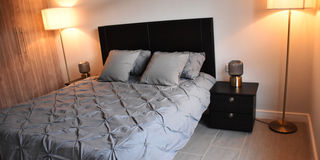Things to know before buying a pillow

Pillows should be changed every two years or less to prevent the cumulation of harmful bacteria. PHOTO/Promise Twinamukye.
What you need to know:
Ideally, a good pillow is one that keeps the sleeper’s spine aligned in a neutral position and comfortable enough to help one sleep
The first pillows I ever bought myself were ordered online. I told a friend I wanted a pillow that I wanted a pillow that was puffy but soft and she showed me some online. So I was excited about my order and for the first few weeks they were perfect until I felt the puffiness ebbing away. I still have the pillows, although they are now flat and soft enough. , but not that firm. Probably, I was looking at the wrong type, or they just had the wrong descriptions.
According to Dr Patrick Sekimpi, head of the orthopedics department at Makerere University College of Health Sciences and Mulago Hospital, a pillow for the head should be as thick as the length from the tip of your shoulder to the base of the neck. That is, not so small or too big so that your neck stays straight as you sleep.
Ideally, a good pillow is one that keeps the sleeper’s spine aligned in a neutral position and comfortable enough to help one sleep. It may be the wrong type of pillow for you when you feel problems.
Pillows can be classified according to stuffing material, size and the purpose for which the pillows are meant to serve.
Stuffing
This is one of the core things one may look for in a pillow. Is it soft, is it hard in between? All those questions can be answered starting with what is stuffed in the pillows.
Memory foam
The most common type of pillows are memory foam pillows and they also come in two categories. According to Carolyn Busingye, the proprietor of household goods shop, The Duvet Lady, in one case, they get a chunk of memory foam and insert it in the pillow casing, making one foam pillow.
“In another case, bits of memory foam are stuffed in the pillow and there is stitching at the end. For this case, the foam is adjustable and you can fluff them around to make a shape you want. If it is too big for you, you can even open it and remove some foam and stitch it again, which is not possible with the rest of the types,” The Duvet Lady proprietor says.
Fibre pillows
These are made of polyester or more synthetic materials. According to downlinens.com, they offer a more affordable hypoallergenic option, while still providing the cushiness, loftiness and softness.
Busingye says she has not heard complaints from clients who have bought them. “They are popular with school children because they provide them with a level of comfort,” she says.
Feather pillows
These are filled with feathers; usually ducks and geese feathers. They are generally soft except when the quills poke out. To prevent this, use a thick cover.
Down pillows
“These are filled with the undercoating of ducks or geese. The top coating is like a long feather but there are those tiny feathers they put beneath the pillow,” Busingye says.
She adds that they are usually more expensive because of the material and what it takes to get them. They are very soft, floaty, and are dream pillows for most. They are also very warm.
Down alternative pillows
Busingye says these are not filled with actual feathers a synthetic fibre which is made to imitate the down pillows. They can still feel soft, offer good and are more affordable than down. They are also an alternative for those who have different allergic reactions.
Latex
In these pillows, gel is used with foam to create a softer feel. Because they are able to control temperature they are recommended for people who experience night sweats. Some other materials may include hybrid pillows, in which different materials are mixed to provide a soft support such as water and wool among others.
Pillow casing material
This is the casing that holds the stuffed material. Cotton is the most common type because it is a natural fibre, breathable, soft but absorbs water (sweat) and takes a long time to dry. This may be high maintenance for sweaty sleepers.
There is also polyester covering, although they are mostly mixed with other materials such as cotton and silk casings which is a delicate material that requires washing frequently.
Size
There are different sizes of pillows. There is a standard pillow size which is 20 X 26 inches, super standard which is 20 X 28 inches.
Queen pillows are 20X 30 inches while king pillows are 20 X 36 inches.
Pillows can go as low as Shs8, 000 and as high as Shs200, 000, depending on the type and where you buy them.
Sleeping style
Do you sleep mostly on your back, your side, or your stomach? Generally, if you are a side sleeper, you want a fuller pillow that makes up for the gap between the bed and your upper back and shoulder blades. It will help keep your neck aligned with your spine rather than angled to avoid any strain. Back sleepers need flatter pillows since that gap is smaller, due to the curve of the upper back and shoulder blades. If you sleep on your stomach, a thin pillow is enough to keep your neck’s natural curve.




